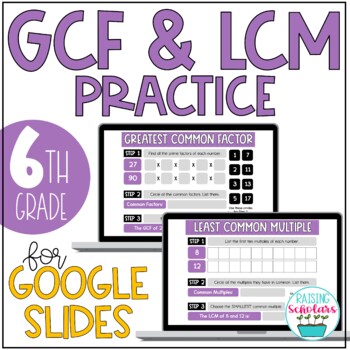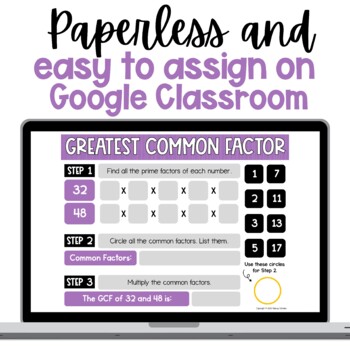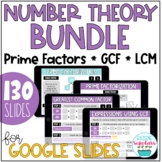GCF & LCM Digital Math Practice Google Slides
- Zip
- Google Apps™
- Internet Activities

What educators are saying
Also included in
- In this bundle, there are a total of 130 Google Slides that practice basic number theory skills, including prime factorization with factor trees, prime factorization with divisibility rules, greatest common factor (GCF), least common multiple (LCM), and writing expressions using GCF and the distribuPrice $13.80Original Price $17.25Save $3.45
Description
In this digital resource, students practice finding the greatest common factor and least common multiple in Google Slides. Students are presented with two numbers on each slide and follow steps that take them through the process of finding the GCF or LCM of two numbers. There are a total of 30 slides (15 for each skill).
This resource aligns with part of the following 6th grade CCSS standard:
- Find the greatest common factor of two whole numbers less than or equal to 100 and the least common multiple of two whole numbers less than or equal to 12. Use the distributive property to express a sum of two whole numbers 1-100 with a common factor as a multiple of a sum of two whole numbers with no common factor.
This digital practice is perfect for distance learning as it is completely paperless and easy to assign on Google Classroom. You can assign as little or as many slides as you want and rearrange the slides to meet the needs of your students.
With this purchase, you will receive:
- link to 30 Google Slides
- PowerPoint version of all slides
- Answer key to all slides
If you need more basic practice with prime factorization, please check out:
Prime Factorization Digital Practice
Prime Factorization Digital Practice with Divisibility Rules
If you want practice that aligns with the second part of 6.NS4, please check out:
Writing Expressions Using GCF Digital Practice
Want to try a sample before you decide to purchase? Click below:
Number Theory Digital Practice FREEBIE
If you like this resource, please check out my other products:
Click HERE to follow my store!
Purchasing this resource gives you the license to use in YOUR CLASSROOM only. If you want to share with other teachers, please purchase additional licenses upon checkout or after purchasing. Multiple licenses are offered at a discount for your convenience. Because I spend countless hours creating resources, I simply ask that you respect the time and effort that I put into them.
Don’t forget to LEAVE FEEDBACK, which earns you credit toward future TpT purchases. Thank you!






